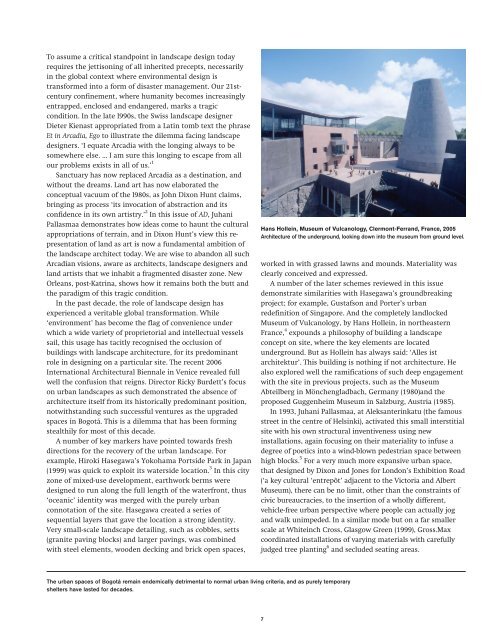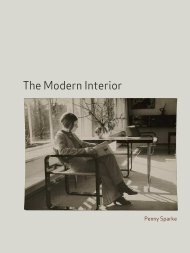Landscape Architecture: Landscape Architecture: - School of ...
Landscape Architecture: Landscape Architecture: - School of ...
Landscape Architecture: Landscape Architecture: - School of ...
- No tags were found...
You also want an ePaper? Increase the reach of your titles
YUMPU automatically turns print PDFs into web optimized ePapers that Google loves.
To assume a critical standpoint in landscape design today<br />
requires the jettisoning <strong>of</strong> all inherited precepts, necessarily<br />
in the global context where environmental design is<br />
transformed into a form <strong>of</strong> disaster management. Our 21stcentury<br />
confinement, where humanity becomes increasingly<br />
entrapped, enclosed and endangered, marks a tragic<br />
condition. In the late l990s, the Swiss landscape designer<br />
Dieter Kienast appropriated from a Latin tomb text the phrase<br />
Et in Arcadia, Ego to illustrate the dilemma facing landscape<br />
designers. ‘I equate Arcadia with the longing always to be<br />
somewhere else. … I am sure this longing to escape from all<br />
our problems exists in all <strong>of</strong> us.’ 1<br />
Sanctuary has now replaced Arcadia as a destination, and<br />
without the dreams. Land art has now elaborated the<br />
conceptual vacuum <strong>of</strong> the l980s, as John Dixon Hunt claims,<br />
bringing as process ‘its invocation <strong>of</strong> abstraction and its<br />
confidence in its own artistry.’ 2 In this issue <strong>of</strong> AD, Juhani<br />
Pallasmaa demonstrates how ideas come to haunt the cultural<br />
appropriations <strong>of</strong> terrain, and in Dixon Hunt’s view this representation<br />
<strong>of</strong> land as art is now a fundamental ambition <strong>of</strong><br />
the landscape architect today. We are wise to abandon all such<br />
Arcadian visions, aware as architects, landscape designers and<br />
land artists that we inhabit a fragmented disaster zone. New<br />
Orleans, post-Katrina, shows how it remains both the butt and<br />
the paradigm <strong>of</strong> this tragic condition.<br />
In the past decade, the role <strong>of</strong> landscape design has<br />
experienced a veritable global transformation. While<br />
‘environment’ has become the flag <strong>of</strong> convenience under<br />
which a wide variety <strong>of</strong> proprietorial and intellectual vessels<br />
sail, this usage has tacitly recognised the occlusion <strong>of</strong><br />
buildings with landscape architecture, for its predominant<br />
role in designing on a particular site. The recent 2006<br />
International Architectural Biennale in Venice revealed full<br />
well the confusion that reigns. Director Ricky Burdett’s focus<br />
on urban landscapes as such demonstrated the absence <strong>of</strong><br />
architecture itself from its historically predominant position,<br />
notwithstanding such successful ventures as the upgraded<br />
spaces in Bogotá. This is a dilemma that has been forming<br />
stealthily for most <strong>of</strong> this decade.<br />
A number <strong>of</strong> key markers have pointed towards fresh<br />
directions for the recovery <strong>of</strong> the urban landscape. For<br />
example, Hiroki Hasegawa’s Yokohama Portside Park in Japan<br />
(1999) was quick to exploit its waterside location. 3 In this city<br />
zone <strong>of</strong> mixed-use development, earthwork berms were<br />
designed to run along the full length <strong>of</strong> the waterfront, thus<br />
‘oceanic’ identity was merged with the purely urban<br />
connotation <strong>of</strong> the site. Hasegawa created a series <strong>of</strong><br />
sequential layers that gave the location a strong identity.<br />
Very small-scale landscape detailing, such as cobbles, setts<br />
(granite paving blocks) and larger pavings, was combined<br />
with steel elements, wooden decking and brick open spaces,<br />
Hans Hollein, Museum <strong>of</strong> Vulcanology, Clermont-Ferrand, France, 2005<br />
<strong>Architecture</strong> <strong>of</strong> the underground, looking down into the museum from ground level.<br />
worked in with grassed lawns and mounds. Materiality was<br />
clearly conceived and expressed.<br />
A number <strong>of</strong> the later schemes reviewed in this issue<br />
demonstrate similarities with Hasegawa’s groundbreaking<br />
project; for example, Gustafson and Porter’s urban<br />
redefinition <strong>of</strong> Singapore. And the completely landlocked<br />
Museum <strong>of</strong> Vulcanology, by Hans Hollein, in northeastern<br />
France, 4 expounds a philosophy <strong>of</strong> building a landscape<br />
concept on site, where the key elements are located<br />
underground. But as Hollein has always said: ‘Alles ist<br />
architektur’. This building is nothing if not architecture. He<br />
also explored well the ramifications <strong>of</strong> such deep engagement<br />
with the site in previous projects, such as the Museum<br />
Abteilberg in Mönchengladbach, Germany (1980)and the<br />
proposed Guggenheim Museum in Salzburg, Austria (1985).<br />
In 1993, Juhani Pallasmaa, at Aleksanterinkatu (the famous<br />
street in the centre <strong>of</strong> Helsinki), activated this small interstitial<br />
site with his own structural inventiveness using new<br />
installations, again focusing on their materiality to infuse a<br />
degree <strong>of</strong> poetics into a wind-blown pedestrian space between<br />
high blocks. 5 For a very much more expansive urban space,<br />
that designed by Dixon and Jones for London’s Exhibition Road<br />
(‘a key cultural ‘entrepôt’ adjacent to the Victoria and Albert<br />
Museum), there can be no limit, other than the constraints <strong>of</strong><br />
civic bureaucracies, to the insertion <strong>of</strong> a wholly different,<br />
vehicle-free urban perspective where people can actually jog<br />
and walk unimpeded. In a similar mode but on a far smaller<br />
scale at Whiteinch Cross, Glasgow Green (1999), Gross.Max<br />
coordinated installations <strong>of</strong> varying materials with carefully<br />
judged tree planting 6 and secluded seating areas.<br />
The urban spaces <strong>of</strong> Bogotá remain endemically detrimental to normal urban living criteria, and as purely temporary<br />
shelters have lasted for decades.<br />
7



